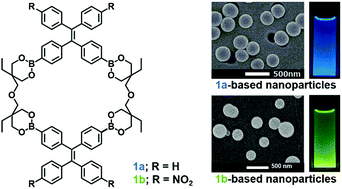Formation of emissive nanoparticles from tetraphenylethylene-containing boronate macrocycles: preparation, characterization and functionalization†
Abstract
[2+2] Macrocycles composed of two tetraphenylethylenes (TPEs) and two linkers, namely 1a (R = H) and 1b (R = NO2), were prepared in a facile manner through the one-pot dehydration of gem-di(boronic acid)-appended TPEs 2a (R = H) and 2b (R = NO2) with di(trimethylolpropane) 3 in MeOH. Considering that use of THF instead of MeOH as the reaction solvent gave a mixture of boronate esters, hydrophobicity-induced non-covalent interactions involving mono(boronate ester) intermediates produced by the dehydration of 2 and 3, may be responsible for the selective cyclization in MeOH. We found that these boronate macrocycles formed emissive nanoparticles of 1a (λem = 483 nm, λex = 365 nm, ΦF = 31%) and 1b (λem = 539 nm, λex = 365 nm, ΦF = 11%) in H2O, with average diameters of 312 ± 44.6 nm and 146 ± 25.5 nm, respectively. The dynamic features of these particles endow them with reversible thermoresponsive properties; indeed, emissiveness responded linearly to temperature over the tested range. The hysteresis-free temperature sensitivity (S) of the 1a-based nanoparticles was determined to be 0.75% K−1 in H2O. Such behavior was rationalized by dynamic light scattering (DLS) experiments, which facilitated the detection of particle-size changes in response to temperature. As a control, bis(pinacolboryl)-appended TPE 6, which does not form nanoparticles in H2O, was poorly responsive to changes in temperature. Furthermore, effective emission quenching was observed upon addition of 2,6-dichloro-4-nitroaniline (DCN), a toxic pesticide, at a detection limit of 2.00 ppm in H2O/MeOH (3 : 2 v/v). Although DCN-induced quenching is ascribable to the nature of the TPE units, the self-assembled nanoparticle morphologies were altered upon addition of DCN, as determined by DLS and field-emission scanning electron microscopy (FE-SEM), and appeared to involve an Ostwald ripening process.



 Please wait while we load your content...
Please wait while we load your content...